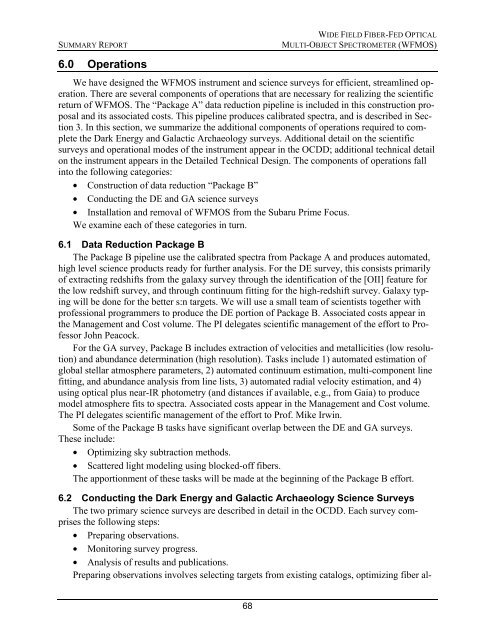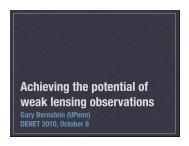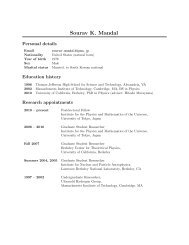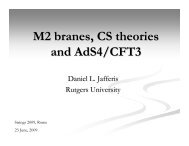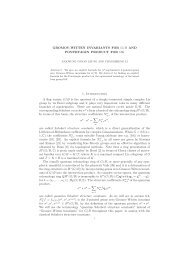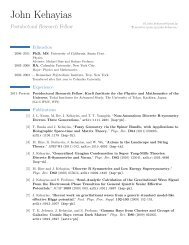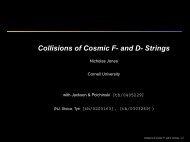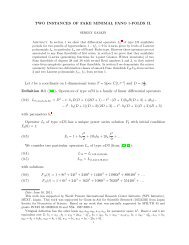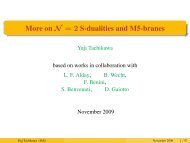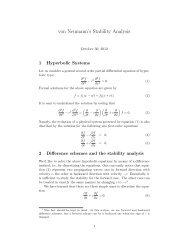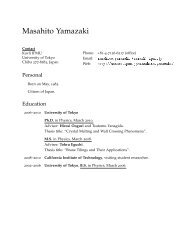STUDY SUMMARY - IPMU
STUDY SUMMARY - IPMU
STUDY SUMMARY - IPMU
Create successful ePaper yourself
Turn your PDF publications into a flip-book with our unique Google optimized e-Paper software.
<strong>SUMMARY</strong> REPORT<br />
WIDE FIELD FIBER-FED OPTICAL<br />
MULTI-OBJECT SPECTROMETER (WFMOS)<br />
6.0 Operations<br />
We have designed the WFMOS instrument and science surveys for efficient, streamlined operation.<br />
There are several components of operations that are necessary for realizing the scientific<br />
return of WFMOS. The “Package A” data reduction pipeline is included in this construction proposal<br />
and its associated costs. This pipeline produces calibrated spectra, and is described in Section<br />
3. In this section, we summarize the additional components of operations required to complete<br />
the Dark Energy and Galactic Archaeology surveys. Additional detail on the scientific<br />
surveys and operational modes of the instrument appear in the OCDD; additional technical detail<br />
on the instrument appears in the Detailed Technical Design. The components of operations fall<br />
into the following categories:<br />
• Construction of data reduction “Package B”<br />
• Conducting the DE and GA science surveys<br />
• Installation and removal of WFMOS from the Subaru Prime Focus.<br />
We examine each of these categories in turn.<br />
6.1 Data Reduction Package B<br />
The Package B pipeline use the calibrated spectra from Package A and produces automated,<br />
high level science products ready for further analysis. For the DE survey, this consists primarily<br />
of extracting redshifts from the galaxy survey through the identification of the [OII] feature for<br />
the low redshift survey, and through continuum fitting for the high-redshift survey. Galaxy typing<br />
will be done for the better s:n targets. We will use a small team of scientists together with<br />
professional programmers to produce the DE portion of Package B. Associated costs appear in<br />
the Management and Cost volume. The PI delegates scientific management of the effort to Professor<br />
John Peacock.<br />
For the GA survey, Package B includes extraction of velocities and metallicities (low resolution)<br />
and abundance determination (high resolution). Tasks include 1) automated estimation of<br />
global stellar atmosphere parameters, 2) automated continuum estimation, multi-component line<br />
fitting, and abundance analysis from line lists, 3) automated radial velocity estimation, and 4)<br />
using optical plus near-IR photometry (and distances if available, e.g., from Gaia) to produce<br />
model atmosphere fits to spectra. Associated costs appear in the Management and Cost volume.<br />
The PI delegates scientific management of the effort to Prof. Mike Irwin.<br />
Some of the Package B tasks have significant overlap between the DE and GA surveys.<br />
These include:<br />
• Optimizing sky subtraction methods.<br />
• Scattered light modeling using blocked-off fibers.<br />
The apportionment of these tasks will be made at the beginning of the Package B effort.<br />
6.2 Conducting the Dark Energy and Galactic Archaeology Science Surveys<br />
The two primary science surveys are described in detail in the OCDD. Each survey comprises<br />
the following steps:<br />
• Preparing observations.<br />
• Monitoring survey progress.<br />
• Analysis of results and publications.<br />
Preparing observations involves selecting targets from existing catalogs, optimizing fiber al-<br />
68


